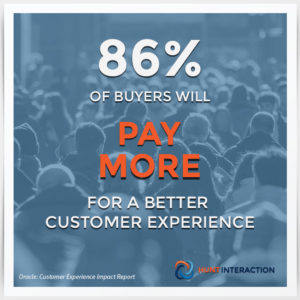A lot of companies think they’re meeting customer needs, after all, they’re raking in the cash and the balance sheet looks healthy. Everything’s great! Then after a while the shock and surprise sets in; customers don’t come through the door at the rate they used to, product returns skyrocket or the “loyal” customers simply don’t come back again.
(This is where the panic sets in and pressure from the board forces you to make some bad decisions.)
If you’ve been playing along at home you know every customer isn’t your ideal customer and different groups of customers add different value to your business. But how do you connect with these valuable customers? How do you find what they really want from your company and if you’re really delivering it to them? The secret lies in psychographic segmentation.
Customers Place Value on More Than Just Price and Convenience
Customers don’t place value on your products based on convenience and pricing anymore – even when it’s easy to order goods and services using your phone, there’s more to customer loyalty than having the best price and quick delivery.
Customers are increasingly becoming more sophisticated and they place value on different things when it comes to giving companies their hard-earned cash. They value things like, ease of purchase, product quality, and durability, environmental stewardship, after-sale customer service, the reputation of the company, etc. Some customer and demographic groups more than others.
Where Do Your Customers Place Value?
Humans are messy and they’re emotional and sometimes irrational. How do you take fuzzy information like “values” and make it quantifiable? The idea of quantifying values is enough to make your CFO hide in the break room for a week.
Easy answer: You ASK customers what they value. Of course, you can’t just come out and say “Hey customer, what do you value?” You have to lean on the relationships you’ve created with customers and ask them to help you make your product and company better. Yep, it’s going to require a healthy dose of humility and checking your ego at the door.
This isn’t about your company’s values, it’s about what your customers value. It’s all about your customers, they’re in the driver’s seat and they have the cash and the loyalty you want.
Why should you even care about your customer’s feelings? And, more importantly, why should you take the time and use the resources needed to answer these questions?
3 Big Benefits of Using Psychographic Segmentation.
When you get up close and personal with your customers and dig into the emotional reasons why they buy, and you collect enough information to start determining patterns you can start reaping customer conversion and loyalty rewards for your company.
Psychographic Segmentation Eliminates Comparison Shopping & Creates Loyalty
If you’re exceeding customer needs and creating value better than your competitors, customers have no reason to leave (your competitors will look like three-day-old leftovers, blech.).
Psychographic Segmentation Guides Product Development
If your ideal customers aren’t buying because they don’t meet their needs or add value, or they want something (a product, feature, even color) you currently don’t offer, wouldn’t you want to know this as quickly as possible so you can adjust marketing and product development efforts?
Psychographic Segmentation Reduces Price Sensitivity
When you deliver products that exceed expectations and make a real difference in your customers’ lives, they’ll pay more.

Beware the “Sweeping Generalizations.”
If you’ve ever heard, “all women like..” or, “all men think like…” you’ve wandered into sweeping generalizations. When you apply a general rule to a specific incidence you’re likely to return with faulty assumptions and overall bad information that can lead you astray.
Customers differ, even in the same segment.
You may find customers in the same behavioral segment value different things. This is normal and this is okay as long as you identify and adapt. Test two different marketing campaigns, each focused on a different value and see which appeals to your ideal customers (you’re currently testing your marketing campaigns, right?).
Getting Customer Information isn’t a one-time project.
Your competitors are also changing and evolving. Constantly gather information from your ideal customers allows you to tweak your marketing and even your product offering before the numbers slump and the board gets testy. Setting up a process in your company to tackle this information is the easiest way to keep on top of what’s going down with your customers and competition.
How Do You Get Killer Customer Qualitative Intelligence?
Excellent Question! In my next blog post, I’ll give you 4 questions to answer on your journey into the emotional morass of your customers and some great (and even free!) sources you can tap to get a ton of killer information.
